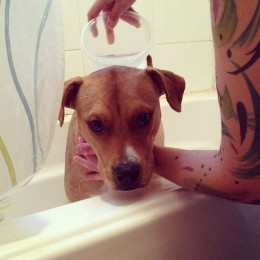How Much Do You Spend on Tattoos

Charrow with her sleeve tattoo and her dog Red
Ink. It’s a thing the kids are doing more and more these days, says the Atlantic!
Growing up in a rapidly changing and challenging world, most young people have struggled at some point or another with figuring out who they might be. Tattoos, recent research suggests, don’t just express identity: They help define it. ….
Some people use institutions such as religion, work, and family to create this [personal] myth. Others use material objects like houses and cars to define it. But Millennials are something of a breed apart. Without access to many of the anchors their parents had to create their personal myths, that sense of stability and permanence is often harder to find.
People rarely get just one tattoo. About half of the inked-up population has between two and five, and 18 percent have six or more. In other words, tattoos aren’t just snapshots. They’re part of the ongoing narrative of the personal myth.
Basically, because we millennials aren’t buying property or working at the Goodyear factory until we hit 65 and can retire with bad knees and a good pension, we need other markers of stable identity in our lives. Tattoos serve that function. But how expensive are they? The Atlantic doesn’t say, so I went searching for answers.
“A good tattoo isn’t cheap, and a cheap tattoo isn’t good” goes the folk wisdom. Not surprising: that’s true for almost everything, isn’t it? Tattoo prices vary considerably, according to body art site Tat2Duck.com.
Most custom artwork will be charged on a shop’s hourly rate. This is particularly true when the piece is large, takes more than one sitting to accomplish or is freehanded on the client. What determines a shop’s hourly rate is their operating cost, the artist’s time, and the artist’s quality and experience. I have been in shops that charge $50 to $60 per hour up to $100 per hour. I have also heard of some artists getting upwards of $200 — $250 per hour.
– Pros: In the long run, this type of pricing may be cheaper than the flat fee. If the artist is experienced and can layout a clean solid outline in a matter of a few minutes, the coloring put in with little effort, your time in the chair can be less than that estimated for the flash sheet, thereby making your price less than the flat fee.
– Cons: The most obvious drawback is that the artist can purposely take longer, forcing the cost to go higher.
Unfortunately there is no way of really knowing if the artist is killing time or just being meticulous. A good precaution is to ask for a time estimate beforehand. However a tattoo is priced, be advised that once set, it is generaly not a good idea to try to haggle down the price. It belittles the artist and makes you look like a cheapskate. If you feel the price is too high, talk to the artist. If your concerns are legitimate, he may reduce it, otherwise look for alternatives. Not having the full amount right then is NOT a legitimate concern.
That too makes sense. Like with a doctor, if someone is holding a very sharp implement against your skin, that’s not a time to act like you’re in a flea market.
Charrow, the delightful illustrator most recently on the site to discuss the costs of pit bull ownership, got a full-color sleeve tattoo as a 30th birthday present to herself. She chose an artist, Amanda Wachob, who charged $350 an hour. (She guesses Wachob now charges $400, if you can get her at all; there’s a waiting list.) Ordinarily she lives an insanely frugal life; the dog and the tattoo are probably her biggest extravagances.
Here’s how it went down, according to Charrow:
I follow a lot of design blogs and she was on them. I loved her work and so I went to the hour she has on sunday that is open consult session. I didn’t get in the first week, but went the next and we had a meeting where I discussed what about her work I liked and what I thought I might want. At our appointment 6 months later she showed me three small paintings. I picked the one I liked and that would be my tattoo.
I completely understood what she was doing because I do the same thing on paper and canvas. It was the exact method of creating artwork and not at all like what I see on tv for tattooing. It was the color mixing and blending that was similar and her image transfer method is the same as what I do. Anyway, she was excellent. Prices do not include tip FYI. I would tip every time. It took three and a half hours total over three sessions, with two weeks of healing time between sessions.
Tattoos aren’t really my thing, but/so I find them intriguing: how do you make an expensive and even painful decision you’ll have to wake up with every day forever? On the other hand, I had a kid, so who am I to talk.
Support The Billfold
The Billfold continues to exist thanks to support from our readers. Help us continue to do our work by making a monthly pledge on Patreon or a one-time-only contribution through PayPal.
Comments